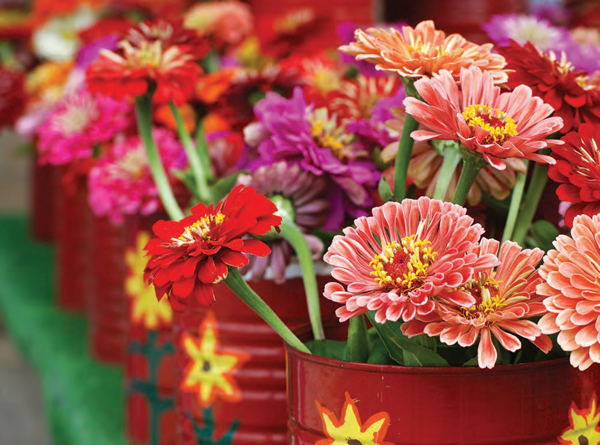Summer Bouquet | Let Zinnias Work Magic in Your Garden
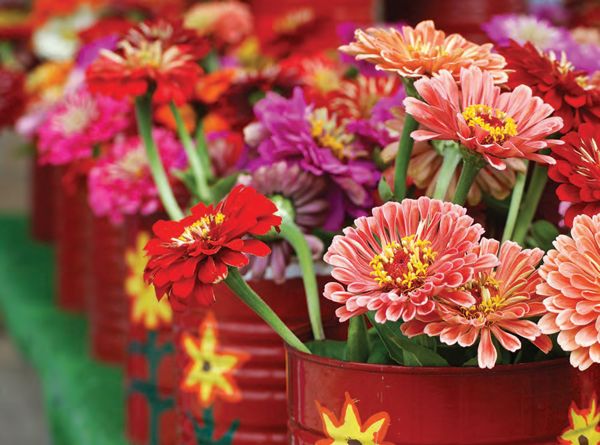
ZINNIAS ARE AN ANNUAL, BUT IF YOU DON’T DEADHEAD THE LAST FLOWER HEADS WHEN WINTER FREEZE KILLS THEM, THEY WILL RESEED IN SPRING. YOU CAN COLLECT DRIED ZINNIA HEADS AND SAVE THEM IN PAPER BAGS IF YOU PREFER TO SET ASIDE YOUR OWN SEEDS EACH YEAR TO SOW IN NEXT YEAR’S GARDEN.
Colorful and tall, zinnias stand out in the garden during hot summer months. Discovered in the late 18th century in a Mexican desert by German botanist Dr. Johann Gottfried Zinn, zinnias quickly became all the rage in American and European gardens. Easy to grow, these versatile flowers bloom from early summer until late fall, and add a fun note of color in your flower beds or the vegetable garden.
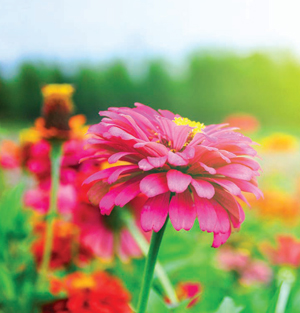 How to grow
How to grow
Zinnias are wonderful bloomers. They provide flowers for cutting bouquets and attract beneficial garden insects all season long. Zinnias can be grown in pots on your deck, but prefer to be in the ground where they have space and can wander. When planted closely together, zinnias grow straighter, taller and yield more blooms. The more you cut, the more they produce, so your garden always provides plenty of blossoms to share.
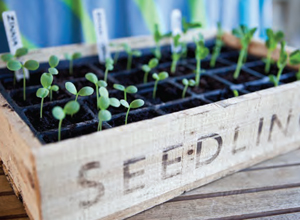 Zinnias are an annual, but if you don’t deadhead the last flower heads when winter freeze kills them, they will reseed in spring. You can collect dried zinnia heads and save them in paper bags if you prefer to set aside your own seeds each year to sow in next year’s garden. Either way, zinnias will grace your garden for your enjoyment once those buds pop in late spring.
Zinnias are an annual, but if you don’t deadhead the last flower heads when winter freeze kills them, they will reseed in spring. You can collect dried zinnia heads and save them in paper bags if you prefer to set aside your own seeds each year to sow in next year’s garden. Either way, zinnias will grace your garden for your enjoyment once those buds pop in late spring.
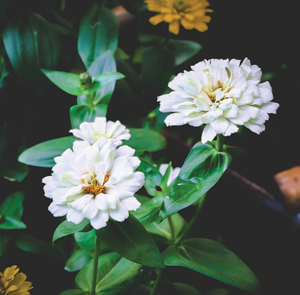 Which variety to plant depends upon your garden and flower-arranging criteria. There are so many collections and each has their own strengths. Profusion, Cut and Come Again, State Fair and Benary Giant are great for big cutting gardens and are resistant to powdery mildew; Lilliput, Whirligig and Zowie Zinnias attract butterflies and wildlife. For dwarf hybrids, the Peter Pan series grows only 12 inches high and allows placement in smaller gardens and containers. Grow the Ruffle varieties for cutting; they tender lots of blooms in a variety of shades.
Which variety to plant depends upon your garden and flower-arranging criteria. There are so many collections and each has their own strengths. Profusion, Cut and Come Again, State Fair and Benary Giant are great for big cutting gardens and are resistant to powdery mildew; Lilliput, Whirligig and Zowie Zinnias attract butterflies and wildlife. For dwarf hybrids, the Peter Pan series grows only 12 inches high and allows placement in smaller gardens and containers. Grow the Ruffle varieties for cutting; they tender lots of blooms in a variety of shades.
ZINNIAS BRING ACTIVITY TO YOUR YARD. BEES LOVE THEM AND MONARCH BUTTERFLIES WILL VISIT YOUR GARDEN FOR THEIR NECTAR ON THEIR WAY SOUTH IN THE FALL.
Zinnias look good and grow well with daisies, Black-eyed Susans, and plants in the mum family. Zinnias positioned in the back of a bed—tall varieties grow from 2 to 4 feet tall—with marigolds and petunias in front make a beautiful cottage garden. For an open field or large, wide flower bed, try planting zinnias with Mexican sunflower, spider flower and native ornamental grasses to create a thick array of color and texture. Dahlias, Queen Anne’s Lace and zinnias fashion a soothing expanse of calm; the combination of these three densely planted can block the view of unsightly areas like the compost bin or trash cans. Dwarf zinnia plants work well in containers since they range from 10 to 14 inches tall.
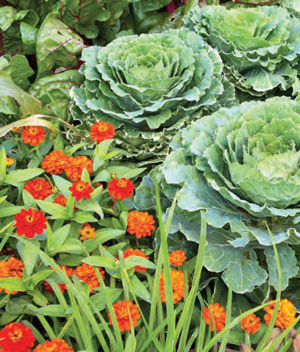 When you plant zinnias in a vegetable garden, place them in the same area as the tomatoes and peppers; they like similar temperature and light. Zinnias love lots of sunlight, fertile soil and dry rather than constantly wet ground. They do need a good drink of water to get them through a hot summer day, so check to make sure they are not too dry or they will wilt. Zinnias are susceptible to powdery mildew, so water only the soil below the leaf line; wet leaves encourage powdery mildew to attack. If your plant gets the disease, pull it out quickly and discard it in the trash. Don’t put it in the compost.
When you plant zinnias in a vegetable garden, place them in the same area as the tomatoes and peppers; they like similar temperature and light. Zinnias love lots of sunlight, fertile soil and dry rather than constantly wet ground. They do need a good drink of water to get them through a hot summer day, so check to make sure they are not too dry or they will wilt. Zinnias are susceptible to powdery mildew, so water only the soil below the leaf line; wet leaves encourage powdery mildew to attack. If your plant gets the disease, pull it out quickly and discard it in the trash. Don’t put it in the compost.
Attracting pollinators
Zinnias bring activity to your yard. Bees love them and monarch butterflies will visit your garden for their nectar on their way south in the fall. Because there are so many varieties of this flower, with different petals and unusual center designs, they never look the same. This diversity appeals to the wildlife as well as to the humans that roam your yard.
Bringing blooms inside
Zinnia blooms are strong and lasting, but their stems are hollow; cut them carefully so they won’t bend or break. Bring a bucket of cool water to place them in so they stay fresh until you get inside to arrange. Since they bloom until frost, they are worth the money and care; they reward you by being the last flowers in the garden, meaning you’ll always have a bouquet on hand.
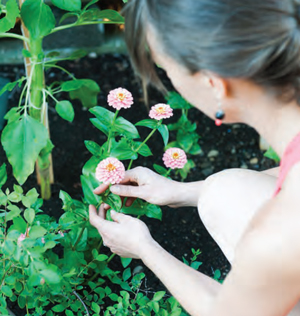 Many gardeners sow more zinnias by seed in mid-summer for early fall blooms. You will also find them potted and ready to plant at your favorite garden store. Whichever one you choose, you will want to plant more next year; these vivid beauties have a way of popping in your thoughts every time you sit down to plan a garden. Gather a bunch to pose in a Mason jar for your picnic or place individual stems in a row of slender vases on your patio table. Zinnias are ready to take the stage when other flowers are fading from summer’s heat. ✦
Many gardeners sow more zinnias by seed in mid-summer for early fall blooms. You will also find them potted and ready to plant at your favorite garden store. Whichever one you choose, you will want to plant more next year; these vivid beauties have a way of popping in your thoughts every time you sit down to plan a garden. Gather a bunch to pose in a Mason jar for your picnic or place individual stems in a row of slender vases on your patio table. Zinnias are ready to take the stage when other flowers are fading from summer’s heat. ✦
annuals, Benary Giant, bloomers, Cut and Come Again, garden, Lilliput, Profusion, State Fair, Whirligig, zinnias, Zowie
